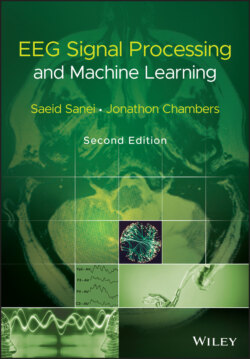Читать книгу EEG Signal Processing and Machine Learning - Saeid Sanei - Страница 35
2.9.3 Psychiatric Disorders
ОглавлениеNot only can functional and certain anatomical brain abnormalities be investigated using EEG signals, pathophysiological brain disorders can also be studied by analyzing such signals. According to the ‘Diagnostic and Statistical Manual (DSM) of Mental Disorders’ of the American Psychiatric Association, changes in psychiatric education have evolved considerably since the 1970s. These changes have mainly resulted from physical and neurological laboratory studies based upon EEG signals [57].
There have been evidences from EEG coherence measures suggesting differential patterns of maturation between normal and learning disabled children [58]. This finding can lead to the establishment of some methodology in monitoring learning disorders.
Several psychiatric disorders are diagnosed by analysis of EPs achieved by simply averaging a number of consecutive trails having the same stimuli.
Some pervasive mental disorders such as: dyslexia which is a developmental reading disorder; autistic disorder which is related to abnormal social interaction, communication, and restricted interests and activities, and starts appearing from the age of three; Rett's disorder, characterized by the development of multiple deficits following a period of normal postnatal functioning; and Asperger's disorder which leads to severe and sustained impairments in social interaction and restricted repetitive patterns of behaviour, interests, and activities; cause significant losses in multiple functioning areas [57].
ADHD and attention‐deficit disorder (ADD), conduct disorder, oppositional defiant disorder, and disruptive behaviour disorder have also been under investigation and considered within the DSM. Most of these abnormalities appear during childhood and often prevent children from learning and socializing well. The associated EEG features have been rarely analytically investigated, but the EEG observations are often reported in the literature [59–63]. However, most of such abnormalities tend to disappear with advancing age.
EEG has also been analyzed recently for the study of delirium [64, 65], dementia [66, 67], and many other cognitive disorders [68]. In EEGs, characteristics of delirium include slowing or dropout of the posterior dominant rhythm, generalized theta or delta slow‐wave activity, poor organization of the background rhythm, and loss of reactivity of the EEG to eye opening and closing. In parallel with that, the quantitative EEG (QEEG) shows increased absolute and relative slow‐wave (theta and delta) power, reduced ratio of fast‐to‐slow band power, reduced mean frequency, and reduced occipital peak frequency [65].
Dementia includes a group of neurodegenerative diseases that cause acquired cognitive and behavioural impairment of sufficient severity to interfere significantly with social and occupational functioning. Alzheimer’s disease is the most common of the diseases that cause dementia. At present, the disorder afflicts approximately 5 million people in the United States and more than 30 million people worldwide. Larger numbers of individuals have lesser levels of cognitive impairment, which frequently evolves into full‐blown dementia. Prevalence of dementia is expected to nearly triple by 2050, since the disorder preferentially affects the elderly, who constitute the fastest‐growing age bracket in many countries, especially in industrialized nations [67].
Among other psychiatric and mental disorders, amnestic disorder (or amnesia), mental disorder due to general medical condition, substance‐related disorder, schizophrenia, mood disorder, anxiety disorder, somatoform disorder, dissociative disorder, sexual and gender identity disorder, eating disorders, sleep disorders, impulse‐controlled disorder, and personality disorders have often been addressed in the literature [57]. However, the corresponding EEGs have been seldom analyzed by means of advanced signal processing tools.
